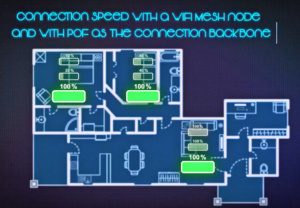KDPOF introduces a Plastic Optical Fiber backbone inside the home: in combination with Wi-Fi access points, POF provides end users with maximum performance for both wireless and wired connectivity throughout the house. POF reuses any existing conduits in the home, making these cables invisible. “ISPs and Telecom operators are offering higher and higher access speeds while users at home are locally connecting more and more devices to the internet,” explained Carlos Pardo, CEO and Co-Founder of KDPOF. “The paradox is that while access speeds have increased, customer satisfaction rates drop if home networks cannot keep up.” Read more

Video: with a POF backbone inside the home with Wi-Fi access points, KDPOF provides maximum performance for both wireless and wired connectivity throughout the house.
Although ISPs and Telecom have increased access speeds, customer satisfaction rates drop if home networks cannot keep up. This is particularly worrisome because Quality of Experience has become a very important differentiator for broadband service providers. Customers expect to experience the speeds they are paying for. With a Plastic Optical Fiber (POF) backbone inside the home with Wi-Fi access points, KDPOF provides end users maximum performance for both wireless and wired connectivity throughout the house. POF reuses any existing conduits in the home making these cables invisible to customers.
Sara Martin-Sanz Albendea, Project Manager with Telefónica and responsible for the project known within Telefónica as ‘Plastic Optical Fiber in the House’: “KDPOF offers a great solution for improving customer satisfaction. Quality of Experience is a key success factor for Telefónica.” Read more
While ISPs and Telecom operators are offering higher and higher access speeds, users at home are connecting more and more devices locally to the internet, mostly over Wi-Fi. Applications like online gaming and video streaming are pushing the requirements of the home network today and will increase tomorrow with new applications such as Virtual Reality. Solutions for home connectivity are needed to maintain wireless performance all around the home. Please watch how Plastic Optical Fiber (POF) as connection backbone supporting multiple Wi-Fi mesh nodes maximizes performance up to 100 percent of the access speed. The POF backbone is an in-wall cabling solution that in conjunction with individual Wi-Fi nodes marries the benefits of both Wi-Fi and POF: mobility of wireless, reliability of wires, and no wires seen of POF and Wi-Fi.
KDPOF proudly announces the successful completion of the H2020 Project, a considerable EU Research and Innovation program running from 2014 to 2020. KDPOF’s target was to take the next steps into replicating and validating their Plastic Optical Fiber (POF) technology to implement and standardize a robust solution in the automotive industry after having successfully launched and qualified a family of ASICs for the consumer and professional markets. “Our goal was to design, develop, validate, and pre-qualify an ASIC for gigabit communications over POF for automotive applications,” explained Carlos Pardo, CEO and Co-founder of KDPOF. The purpose of the project was to undertake the product development process with a quality approach that guarantees compliance to the automotive industry’s requirements. “The successful development and validation of a gigabit POF transceiver that demonstrates functional, performance, and reliability compliance for automotive applications represents a major breakthrough in a new communications standard for the automotive industry.”
Read more
KDPOF has been nominated as a Venture Capital finalist at the 4th edition of the Tech Tour 2018 European Photonics Venture Forum (EPVF) on May 29-30, 2018 in Barcelona, Spain. The event was hosted at ICFO (The Institute of Photonic Sciences) with the following supporters: the EU and the European projects ACTPHAST 4.0, SECPhO, as well as Photonics21, Fotónica21, and ECOP (European Centres for Outreach in Photonics). The European Photonics Venture Forum is an annual event held in a new city each year, featuring the activities of Europe’s leading photonics clusters including all technical applications of light such as lasers, photovoltaics, lighting, screens and displays, sensors, optical fibers, and optoelectronics. Read more








 KDPOF
KDPOF
